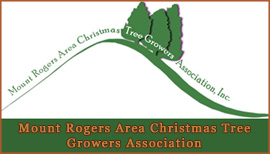Going shopping?
These tips can help you find the perfect Christmas Tree
at a retail lot or fresh from the farm!
Selecting a Christmas Tree at a
Choose & Cut Farm
Remember, the Christmas trees purchased from local Christmas tree farms are as fresh as a Christmas tree can ever be.
- Most tree farms keep their fields very well groomed, but there are some things that are beyond the farmer's control. Be careful of tree stumps, an occasional blackberry vine, uneven ground and sharp saws.
- Go to the farm prepared for a day in the country. Wear comfortable shoes and old clothes. Bring rain gear if the weather is threatening. The "cutter downers" and the "loader uppers" should also have gloves. DON'T FORGET THE CAMERA. It's best to leave "Rover" at home (many farms will prohibit pets). But, if a pet is allowed and must come along; keep him on a leash at all times. Please don't let him "mark" other people's trees.
- Saws are usually provided by the farm operator. Check ahead of time.
- Some farms measure and price their trees individually, others sell them by the foot. Ask about the pricing policy before heading out in the field.
- Head out to the field and select the tree that fits your predetermined needs. Some farms will offer a measuring stick to help you determine height. Also check that the tree has a sufficiently long handle (bare trunk at bottom) to accommodate your stand. Take your stand with you, if it may be difficult to fit.
- In the fall of the year ALL conifers drop, or shed, a certain portion of their oldest needles. This is a normal part of the life cycle of the tree. This phenomena occurs because the tree is preparing itself for winter. Most farms provide shaking, or blowing, services so that you will depart with a perfectly clean tree.
- Cutting the tree is easiest as a two person project. The "cutter downer" usually lies on the ground. While the helper holds the bottom limbs up. While the cut is being made, the helper should tug on the tree lightly to ensure that the saw kerf remains open and the saw does not bind. The tugging force should be applied to the side of the tree opposite the cut.
- Bring the tree to the processing area where it will be cleaned and netted or baled. Netting or baling makes transporting and handling the tree substantially easier.
Selecting a Christmas Tree at a Retail Tree Lot:
Use these practical tips to be a more informed consumer and to ensure a great experience with your Real Tree:
- Be sure you know what size (height and width) you need before heading to the retail lot.
- If you want the same species you know or have always used, great. If you want to try a different species, browse the NCTA website to become familiar with the species popular in your area before heading to the retail lot.
- Go to a retail lot that is well-lit and stores trees in a shaded area.
- Often, a tree obtained soon after its arrival on the retail lot will be very fresh because it was cut recently. Consumers should ask the retailer when he/she gets the trees: are they delivered once at the beginning of the season, or does he/she obtain several shipments during the season.
- Do a freshness test on the trees. Green needles on fresh trees break crisply when bent sharply with the fingers -- much like a fresh carrot.
- Pines have different indicators because of the fibrous nature of their needles compared to firs. The needles on fresh pines do NOT break, unless they are very dry.
- Look for other indicators of dryness or deterioration: excessive needle loss, discolored foliage, musty odor, needle pliability, and wrinkled bark. A good rule-of-thumb is, when in doubt about the freshness of a tree, select another one. If none of the trees on the lot look fresh, go to another lot.
- Some species, such as Fraser Fir, last longer and remain fresh longer than others in different climates. Ask your retailer which tree performs best in your climate.
- Ask the retailer about recycling Christmas Trees in your community.
- Involve the whole family in the selecting and plan fun things for everyone to do during the trip.
Now you're ready to load up and head home to decorate your Real Christmas Tree.
This article used with permission from the National Christmas Tree Association.
(top)
Before you go:
Tips for a Safe Tree:

